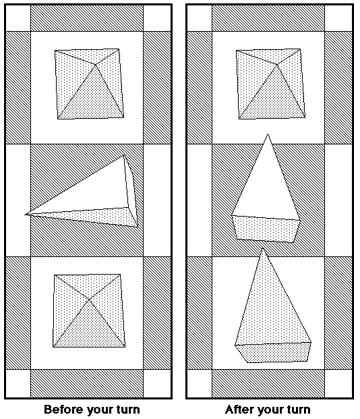
Gridlock is an abstract strategy game for 4 players. To play, you will need a set of Icehouse pyramids, a chessboard, and some sort of token that can be passed around the table and placed in front of each player. We use a little toy model of the van that those meddling kids drove around in on the Scooby Doo show; for this reason, this token will be referred to in these rules as the Mystery Machine.
To play a standard game, give each player a full set of Icehouse pyramids of a single color. If you wish, you can also play a short game, using only 9 pieces, 3 of each size, for each player.
Place one small piece of each color in a hat. Draw one piece out a random. This is the color that will go first. Then draw out a second piece. The second piece indicates the starting position of the Mystery Machine. Place the Mystery Machine in front of the appropriate player.

The game has two phases, the Placement Phase and the Drop Phase. During the first phase, players take turns placing a piece of their choice somewhere on the chessboard. The pyramids are placed in the upright position. Players continue placing pyramids on the chessboard until all players have used up all of their pieces.
During the Drop Phase, each player will choose a piece of their color that is still standing up and "drop" it - that is, knock it over so that it's pointing away from the player. This brings us to a key concept: After a piece has been dropped, its color is no longer significant - what matters then is the direction it is pointing. A piece that is pointing away from you is your piece - that is, you will be the one who gets points for it at the end of the game, provided it is still pointing away from you at that time.
When a piece is dropped, it can "turn" one or more other pieces - that is, change the direction of other pieces along the path in which it is pointing, so that those pieces are also pointing away from the player who dropped the piece. The number of pieces a piece can turn is dependent upon its size; a large pyramid can turn three other pieces, a medium two, and a small piece only one.
On your turn, you choose a piece to drop, and then you turn the correct number of pieces in front of the piece you just dropped, so that they are all pointing away from you.
However: only pieces that are lying down are turned. Pieces that are standing upright are left standing upright. This means that in some cases, particularly early in the game, you won't get to turn any pieces even if you drop a large piece.
The Mystery Machine allows you to skip your turn. Whenever your turn comes up, if you have the Mystery Machine in front of you, you can choose to pass it along to the next player instead of placing or dropping a piece. Of course, you cannot use the Mystery Machine to skip your turn if you were just handed it; however, you can choose to take a turn and hold onto the Mystery Machine for the next round if you wish.
The object of the game is not merely to end up with the most pieces pointing in your direction, but also to have as many pieces as possible lined up in a single column as possible. A single piece pointing in your direction is worth 1 point, but if you have 4 pieces on adjacent square that are all pointing away from you, you get 8 points.
When counting up the score, the best way to avoid confusion is to go around the table and for each player, pick up the pieces they get points for and set them in front of the player, clustered in little groups according to the value of each "chain", where a chain is a group of adjacent pieces pointing in a single direction.
| Chain Length | Point Value | |
| 1 | 1 | |
| 2 | 2 | |
| 3 | 4 | |
| 4 | 8 | |
| 5 | 16 | |
| 6 | 32 | |
| 7 | 64 | |
| 8 | 128 |
Gridlock is optimal with 4 players, so it won't be quite as cool with fewer players, though it can be done.
With 2 players, each player will control 2 colors. Place the chessboard at an angle, so that pieces pointing in 2 directions will both, in a sense, be pointing away from a single player. Each player then essentially plays for both colors as if both colors were being played by individual people. The Mystery Machine moves as it would in a 4 player game. At the end, the scores are counted for each color, then totaled for each player.
Gridlock can also be played with 3 players; however, in such a game, one player will be unopposed - that is, he or she won't have anyone going in the exact opposite direction. This can be an advantage, though if both of the other players work to interfere with the third player, this advantage may not mean very much.